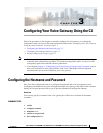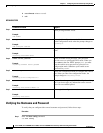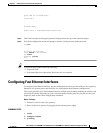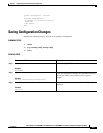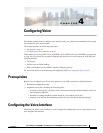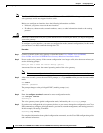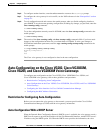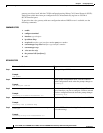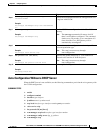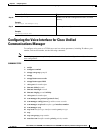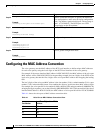
4-3
Cisco VG202, Cisco VG202XM, Cisco VG204, and Cisco VG204XM Voice Gateways Software Configuration Guide
OL-16191-01
Chapter 4 Configuring Voice
Auto-Configuration on the Cisco VG202, Cisco VG202XM, Cisco VG204, and Cisco VG204XM Voice Gateways
Step 6 To configure another interface, enter the exit command to return to the VG(config)# prompt.
Step 7 To configure the voice gateway for voice traffic, see the VoIP references in the “Prerequisites” section
on page 4-1.
Step 8 To exit configuration mode and return to the enable prompt, when you finish configuring interfaces,
press Ctrl-Z. To see the current operating configuration, including any changes you just made, enter the
show running-config command:
VG# show running-config
To see the configuration currently stored in NVRAM, enter the show startup-config command at the
enable prompt:
VG# show startup-config
Step 9 The results of the show running-config and show startup-config commands differ if you have made
changes to the configuration but have not yet written them to NVRAM. To write your changes to
NVRAM and make them permanent, enter the copy running-config startup-config command at the
enable prompt:
VG# copy running-config startup-config
Building configuration. . .
[OK]
VG#
The Cisco voice gateway is now configured to boot in the new configuration.
Auto-Configuration on the Cisco VG202, Cisco VG202XM,
Cisco VG204, and Cisco VG204XM Voice Gateways
To configure auto-configuration on the Cisco VG202, Cisco VG202XM, Cisco VG204, and
Cisco VG204XM voice gateways, follow these guidelines and procedures.
• Restriction for Configuring Auto-Configuration
• Auto-Configuration on the Cisco VG202, Cisco VG202XM, Cisco VG204, and Cisco VG204XM
Voice Gateways
• Configuring the Voice Interface for Cisco Unified Communications Manager
• Configuring the MAC Address Convention
Restriction for Configuring Auto-Configuration
Before you can connect the voice gateway to the network, you must provision the Cisco Unified
Communications Manager (CUCM) with the voice gateway information.
Auto-Configuration With a DHCP Server
When the Dynamic Host Configuration Protocol (DHCP) server is available, the voice gateway sends a
DHCP server request to provide the IP address for the Fast Ethernet 0/0 interface, and the TFTP server’s
IP address using the DHCP option 150. When the DHCP server provides the information, the voice



